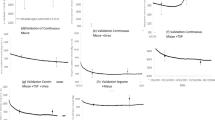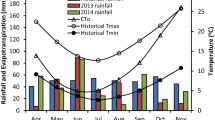Abstract
Poor soil fertility is the biggest obstacle to agricultural productivity in Sub-Saharan Africa. Improved fallows can help to raise agricultural productivity in these systems of low financial capital, however, experimental testing of their potential application domain and design is costly and time consuming. Models can evaluate alternative systems relatively quickly and at relatively low cost, but must first be validated to assess satisfactory simulation of the target systems. Specific climatic, edaphic, crop and fallow growth data was used from five sites in Western Kenya to calibrate and validate simulations of maize and improved fallow growth using the Water, Nutrient and Light Capture in Agroforestry Systems (WaNuLCAS) model. The model predicted continuous maize yields across the sites with an R 2 of 0.72, an EF (model efficiency) of 0.66 and a CD (coefficient of determination) of 2.73, although the default pedotransfer functions (PTF) for volumetric soil water content used in the model had to be substituted for a tropical soils specific PTF before this was achieved. Predicted maize yield was consistently related to fallow biomass (i.e. higher fallow biomass correlated with higher subsequent maize yields) at two sites and the model predicted maize yields following fallow growth from this subset of the data with an R 2 of 0.42. This relationship of fallow biomass to subsequent maize yield was not observed across the whole data set due to incomplete fallow litterfall data, factors not included in the model and associated poor model prediction of recycled tree biomass. After site and tree calibration, the model can thus be applied to assess fallow management strategies for sites limited by water and nitrogen.








Similar content being viewed by others
References
Aweto AO (1981) Secondary succession and soil fertility restoration in south-western Nigeria. II Soil fertility restoration. J Ecol 69:609–614
Brady NC (1996) Alternatives to slash-and-burn: a global imperative. Agric, Ecosys Environ 58:3–11
Buresh RJ, Tian G (1997) Soil improvement by trees in sub-Saharan Africa. Agrofor Sys 38:51–76
David S and Swinkels RA (1994) Socio-economic characteristics of households engaged in agroforestry technology testing in western Kenya. Rep. No. 78 International Centre for Research in Agroforestry (ICRAF), Nairobi, Kenya
Diels J, Vanlauwe B, van de Meersch M K, Sanginga N and Merckx R (2005) Long-term soil organic carbon dynamics in a subhumid tropical climate: 13C data in mixed C3/C4 cropping and modelling with ROTHC. Soil Biol Biochem 36:1739–1750
FAO (1996) Soil fertility initiative. Food and Agriculture Organization of the United Nations, Rome, Italy
Gathumbi SM, Cadisch G, Giller KE (2002) 15N natural abundance as a tool for assessing N2- fixation of herbaceous, shrub and tree legumes in improved fallows. Soil Biology and Biochemistry 34:1059–1071
Giller KE, Cadisch G (1995) Future benefits from biological nitrogen fixation: An ecological approach to agriculture. Plant Soil 174:255–277
Giller KE, Cadisch G, Ehaliotis C, Adams E, Sakala WD, Mafongoya PL (1997) Building soil nitrogen capital in Africa. In: Buresh RJ, Sanchez PA, Calhoun F (eds) Replenishing soil fertility in Africa. ASSA, CSSA, SSSA, Madison, Wisconsin, pp 151–192
Hodnett MG, Tomasella J (2002) Marked differences between van Genuchten soil water-retention parameters for temperate and tropical soils: a new water-retention pedo-transfer functions developed for tropical soils. Geoderma 108:155–180
INCO-DEV (2002) Improved fallows by legume plants (trees, shrubs and grasses) in Eastern and Southern Africa. Second Annual Report. INCO-DEV: International Cooperation with Developing Countries. EU, Brussels, Belgium
Kinyangi J, Delve RJ and Probert ME (2004) Testing the APSIM Model with Data from a Phosphorus and Nitrogen Replenishment Experiment on an Oxisol in Western Kenya. In: Delve RJ, Probert ME (eds) Modelling nutrient management in tropical cropping systems. ACIAR Proceedings No. 114, Canberra, Australia, pp 101–109
Loage K, Green RE (1991) Statistical and graphical methods for evaluating solute transport models: Overview and application. J Contaminant Hydrol 7:51–73
Mafongoya PL, Dzowela BH (1999) Biomass production of tree fallows and their residual effect on maize in Zimbabwe. Agrofor Sys 47:139–151
Marschner H (1986) Mineral nutrition of higher plants. Academic Press, London
Matthews RB (2002) Introduction. In: Matthews RB, Stephens W (eds) Crop—Soil simulation models: applications in developing countries. CAB International, Wallingford, Oxon
Maulem Y (1976) A new model for predicting the hydraulic conductivity of unsaturated porous media. Water Resour Res 12:513–522
Mutuo PK (2004) Potential of improved tropical legume fallows and zero tillage practices for soil organic carbon sequestration. PhD thesis, Department Agricultural Sciences. University of London, Wye Campus, Wye, UK, p 283
Mutuo PK, Cadisch G, Albrecht A, Palm CA, Verchot L (2005) Potential of agroforestry for carbon sequestration and mitigation of greenhouse gas emissions from soils in the tropics. Nutr Cycl Agroecosyst 71:43–54
Mutuo PK, Shepherd KD, Albrecht A, Cadisch G (2006) Prediction of Carbon Mineralization Rates from Soil Physical Fractions Using Diffuse Reflectance Spectroscopy. Soil Biol Biochem 38:1658–1664
Nair PKR (1997) Directions in tropical agroforestry research: past, present, and future. Agrofor Sys 38:223–247
Ndufa J K 2001 Nitrogen and Soil Organic Matter Benefits to Maize by Fast-Growing Pure and Mixed Species Legume Fallows in Western Kenya. PhD thesis, Imperial College at Wye, University of London, Wye, Ashford, Kent
Parton WJ, Schimel DS, Cole CV, Ojima DS (1987) Analysis of factors controlling soil organic matter levels in Great Plains Grasslands. Soil Sci Soc Am J 51:1173–1179
Rowe EC, Hairiah K, Giller KE, Van Noordwijk M, Cadisch G (1998) Testing the safetynet role of hedgerow tree roots by 15N placement at different soil depths. Agrofor Sys 43:81–93
Rykiel EJ (1996) Testing ecological models: the meaning of validation. Ecol Modelling 90:229–244
Sanchez PA (1999) Improved fallows come of age in the tropics. Agrofor Sys 47:3–13
Shepherd KD (2004) Predicting decomposition rates of organic resources using near infrared spectroscopy. In: Delve RJ, Probert ME (eds) Modelling nutrient management in tropical cropping systems. ACIAR, Canberra, Australia, p 138
Shepherd KD, Ohlsson E, Okalebo JR, Ndufa JK (1996) Potential impact of agroforestry on soil nutrient balances at the farm scale in the East African Highlands. Fertilizer Res 44:87–99
Shepherd KD, Swinkels RA, Muturi WM, Ohlsson E, Ndufa JK (1992) Evaluation of hedgerow intercropping on farms in western Kenya. I. Diagnosis of technology potential and farmers’ interest. Rep. No. 50, International Centre for Research in Agroforestry (ICRAF), Nairobi, Kenya
Sitompul SM, Hairiah K, Cadisch G, van Noordwijk M (2000) Dynamics of density fractions of macro-organic matter after forest conversion to sugarcane and woodlots, accounted for in a modified CENTURY model. Netherlands J Agric Sci 48:61–73
STELLA (1994) STELLA II technical documentation. High Performance Systems Inc., Hanover, USA
Swinkels R, Franzel S (1997) Adoption potential of hedgerow intercropping in maize—based cropping systems in the highlands of Western Kenya. 2. Economic and farmers’ evaluation. Exp Agric 33:211–223
Szott LT, Palm CA, Buresh RJ (1999) Ecosystem fertility and fallow function in the humid and subhumid tropics. Agrofor Sys 47:163–197
Valentin C, Rajot JL, Mitja D (2005) Responses of soil crusting, runoff and erosion to fallowing in the sub-humid and semi-arid regions of West Africa. Agric, Ecosys Environ 104:287–302
Van Genuchten MT (1980) A closed-form equation for predicting the hydraulic conductivity of unsaturated soils. Soil Sci Soc Am J 44:892–898
Van Noordwijk M, Lusiana B (1999) WaNuLCAS, a model of water, nutrient and light capture in agroforestry systems. Agrofor Sys 43:217–242
Van Noordwijk M, Lusiana B, Khahasanah N (2004) WaNuLCAS version 3.1, Background on a model of water nutrient and light capture in agroforestry systems. International Centre for Research in Agroforestry (ICRAF), Bogor, Indonesia
Van Noordwijk M, Mulia R (2005) Press Functional branch analysis as tool for fractal scaling above- and belowground trees for their additive and non-additive properties. Ecol Model 149:41–51
Van Noordwijk M, van de Geijn SC (1996) Root, Shoot and soil parameters required for process oriented models of crop growth limited by water or nutrients. Plant Soil 183:1–25
Woomer PL (1993) Modelling soil organic matter dynamics in tropical ecosystems: Model adoption, uses and limitations. In: Mulongoy K, Merckx R (eds) Soil organic matter dynamics and sustainability of tropical agriculture. John Wiley & Sons, Leuven, Belgium, pp 279–294
Wösten JHM, Lilly A, Nemes A and Le Bas C (1998) Using existing soil data to derive hydraulic parameters for simulation models in environmental studies and in land use planning. Report 156, SC-DLO, Wageningen (the Netherlands), p 106
Author information
Authors and Affiliations
Corresponding author
Rights and permissions
About this article
Cite this article
Walker, A.P., Mutuo, P.K., van Noordwijk, M. et al. Modelling of planted legume fallows in Western Kenya using WaNuLCAS. (I) Model calibration and validation. Agroforest Syst 70, 197–209 (2007). https://doi.org/10.1007/s10457-007-9049-6
Received:
Revised:
Accepted:
Published:
Issue Date:
DOI: https://doi.org/10.1007/s10457-007-9049-6




